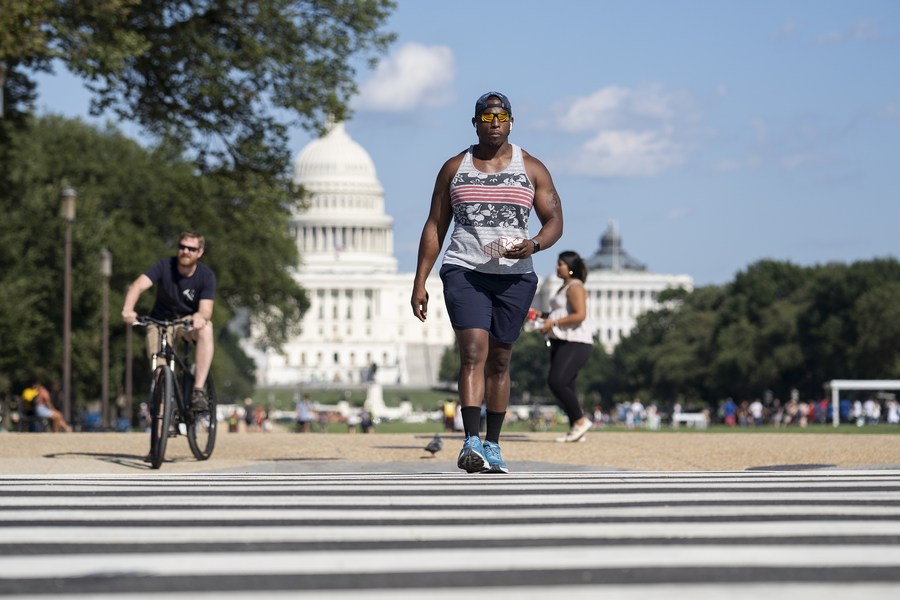U.S. faces challenges to achieve broader vaccination against COVID-19 in winter months

People are seen on the National Mall in Washington, D.C., the United States, on Sept. 6, 2021. (Xinhua/Liu Jie)
"The COVID-19 pandemic is not over, and the risk of both flu and COVID-19 circulating could put additional strain on hospitals and frontline health care professionals," U.S. CDC Director Rochelle Walensky warned.
NEW YORK, Oct. 8 (Xinhua) -- The upcoming colder months are posing a challenge for the United States to advance its vaccination efforts against the coronavirus, which have been bringing down the number of cases and hospitalizations in a steady pace, health officials and experts have said.
Currently, fewer than 70,000 U.S. hospital beds are occupied by COVID-19 patients, accounting for less than 25 percent of intensive care unit (ICU) beds nationwide, compared with over 100,000 beds filled and more than 30 percent ICU occupancy rate in early September, according to a report by CNN on Thursday.
Meanwhile, the average of new coronavirus infections has now dropped to around 106,000 each day and more than half of the U.S. population, 56 percent, is fully vaccinated against COVID-19, compared with 159,000 daily coronavirus infections in early September, the report said.
"We haven't put up a 'mission accomplished' banner yet, but for sure we think things are improving. New cases and hospitalizations certainly are down, and here and there, we're actually seeing a reduction in deaths," William Schaffner, a professor in the Division of Infectious Diseases at Vanderbilt University Medical Center in Nashville, Tennessee, was quoted as saying.

People walk past a reminder of COVID-19 prevention measures outside a hospital in New York, the United States, Sept. 6, 2021. (Xinhua/Wang Ying)
On Thursday, U.S. President Joe Biden wen to Chicago, appealing to more companies to mandate COVID-19 vaccinations for employees, asking them to take initiative as an effort that he announced last month to require 80 million American workers to get the shot undergoes a rule-making process and may not go into effect for weeks.
According to The New York Times' (NYT) data analysis, the seven-day average of confirmed cases of the pandemic stood at 99,669 nationwide on Thursday, with its 14-day change striking a 22-percent fall. The COVID-19-related deaths were 1,765 on Thursday, with the 14-day change realizing a 13-percent decrease.
COVID-19 COMBINED WITH FLU
According to the most recent data from the U.S. Centers for Disease Control and Prevention (CDC), more people are receiving a booster dose of a COVID-19 vaccine each day than are getting their first shot or are becoming fully vaccinated each day.
CDC data showed more than 6 million fully vaccinated Americans have received a booster dose of a COVID-19 vaccine. An average of 390,444 people are getting a booster shot each day, while only 288,105 people are starting their vaccination series each day and 276,539 people are becoming fully vaccinated each day.
Current recommendations from the CDC are that people over 65, people who have a health condition putting them at greater risk of severe disease if they do get a breakthrough infection or people who face a greater risk of contracting COVID-19 while at work or in their living circumstances can receive a booster dose.

Rochelle Walensky, director of the U.S. Centers for Disease Control and Prevention (CDC), testifies during a Senate Appropriations subcommittee hearing on Review of the FY 2022 Budget Blueprint for the CDC in Washington, D.C., the United States, on May 19, 2021. (Jim Lo Scalzo/Pool via Xinhua)
On Thursday, CDC Director Rochelle Walensky in her weekly briefing urged everyone age 6 months and older should get a flu shot, because last year's flu season was so mild that people don't have the natural immunity to the flu they might have gained if they'd gotten sick.
"The COVID-19 pandemic is not over, and the risk of both flu and COVID-19 circulating could put additional strain on hospitals and frontline health care professionals," she warned, while raising alarms about a decline in the flu vaccination rates among young children, to 59 percent from 64 percent the year before.
Overall vulnerability to flu could be higher in the United States this year due to "relaxed COVID-19 mitigation strategies, increased travel and the reopening of schools," Schaffner, also medical director of the National Foundation for Infectious Diseases, told NYT.
ANTIBODY AND VARIANT
A new study by the New England Journal of Medicine has found that women who received both shots of the Pfizer-BioNTech vaccine generally have a higher level of protection against the coronavirus than men who received the vaccine, reported The Hill on Thursday.
The study surveyed 4,800 vaccinated health care professionals in Israel from December to July, finding that women 65 years or older had a higher antibody count than men in the same age range, at 46 percent compared to 37 percent.
The results also showed that although antibodies against the coronavirus fell for both sexes up to 80 days after receiving the second dose, women still had higher counts of antibodies at their peak level of protection.

A medical worker prepares a dose of COVID-19 vaccine at the Universal Studios Hollywood in Los Angeles, California, the United States, June 18, 2021. (Photo by Zeng Hui/Xinhua)
Meanwhile, a retrospective study by the University of Toronto has found that new variants of SARS-CoV-2 are more virulent and transmissible than the original variant of the virus, and health experts associate these variants of concern (VOCs) with increased risk of hospitalization, ICU admission, and death.
The highest risks were from the Delta variant. In the Delta cases, there was a 108 percent increase in the risk of hospitalization, a 235 percent increased risk of ICU admission, and a 133 percent higher risk of death, compared with the original variant, said the study.
Vaccination reduces the risks of severe disease and death even with the VOCs, and even with increased vaccination, control measures are needed to reduce the spread of the VOCs, the study added.
Photos
Related Stories
- White House backs release of Trump records to Jan. 6 committee
- The world needs a lockdown on politicizing COVID-19 origin-tracing
- Over 2.217 bln COVID-19 vaccine doses administered on Chinese mainland
- Interview: China's anti-COVID-19 support "extremely valuable," says Ecuador's health minister
- Chinese mainland reports 22 imported COVID-19 cases
Copyright © 2021 People's Daily Online. All Rights Reserved.










